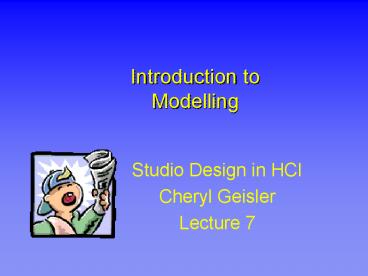Introduction to Modelling - PowerPoint PPT Presentation
1 / 40
Title:
Introduction to Modelling
Description:
... in a timely fashion. Monitoring Contributions. Distribute ... Need to support design work at the level of user's objects & their interactions. How OVID Works ... – PowerPoint PPT presentation
Number of Views:37
Avg rating:3.0/5.0
Title: Introduction to Modelling
1
Introduction to Modelling
- Studio Design in HCI
- Cheryl Geisler
- Lecture 7
2
Agenda
- Teaming Intro to Modelling
- Modelling Problem
- Wide World of Modelling
3
Teaming
4
Role of Teaming
- Major area for individual assessment
- Critical to design success
- General area of weakness
5
Timing
- Doing 1st major assignment
- Two major assignments coming up
- Stress strains
6
Opportunity
- Reflect
- Address
7
Importance of Addressing Teaming
- Team time
- 10 teaming
- 90 designing
- Team failure
- 90 teaming
- 10 designing
8
The Teaming Cycle
9
Frequency of Meetings
Decide
- Not meeting enough
- Meeting too much
Disseminate
Discuss
Work
Propose
Distribute
10
Organization of Team Meetings
Decide
- Issues not raised and discussed in appropriate
order
Disseminate
Discuss
Work
Propose
Distribute
11
Team Schedule
Decide
- Cycle not timed correctly to meet deadlines
Disseminate
Discuss
Work
Propose
Distribute
12
Team Work Plans
Decide
- Work not divided up as needed
Disseminate
Discuss
Work
Propose
Distribute
13
Coordination
- Communication not adequate
Decide
Disseminate
Discuss
Work
Propose
Distribute
14
Listening
Decide
- Proposals not listened to
- Discussion not frank
Disseminate
Discuss
Work
Propose
Distribute
15
Completing Individual Work
Decide
- Work not completed in a timely fashion
Disseminate
Discuss
Work
Propose
Distribute
16
Monitoring Contributions
Decide
- Concerns not expressed and dealt with
Disseminate
Discuss
Work
Propose
Distribute
17
Division of Work
Decide
- Work load not equitable
Disseminate
Discuss
Work
Propose
Distribute
18
Principles Addressing Teaming
- Review the areas
- Avoid blame
- Favor praise
- Be helpful and productive
- Consider your role and responsibility
- Put it on the agenda!
19
Conceptual Design
20
The Phases
- Requirements
- What is Needed
- Conceptual Design
- What will Work
- Implementation
- Making it Work
21
The Methods
- Requirements
- Activity Analysis
- Conceptual Design
- Object Modelling
- Implementation
- Prototyping
22
The Deliverables
- Requirements
- Transformed Narrative
- Conceptual Design
- Model of the HCI
- Implementation
- Prototype of the HCI
23
The System
Transformed Narrative
24
Benefits to the HCI
- built upon analysis of cultural practices
- built upon an underlying conceptual model
- more than haphazard prototype
25
Intro to OVID
26
OVID Methodology
- OVID
- Object
- View
- Interaction Design
27
OVID Defined
- the underlying objects in an HCI
- seen through the Views of the user
- In their Interactions among one another
- Represented in an abstract Diagram
28
OVID Origins
- 1998
- Designing for the User with OVID
- Extending OOM to HCI
29
OOM Origins
- 1997
- Object-Oriented Modeling and Design
- GE / Rational
30
OVID References
- http//www-3.ibm.com/ibm/easy/eou_ext.nsf/Publish/
589 - Designing for the User with OVID Bridging User
Interface Design and Software Engineering. Dave
Roberts, Dick Berry, Scott Isensee and John
Mullaly. Esp Chapter 5.
31
Problem of Multidisciplinarity
- Multiple Disciplines
- Programmer
- Graphics designer
- Usability
- HCI designer
- Each with their own methods
32
Problem of Abstraction
- User Interface 10
- User Interactions 30
- User Objects Interactions 60
- ERGO
- Need to support design work at the level of
users objects their interactions
33
How OVID Works
- An abstract model of
- The objects the user interacts with
- The ways they interact
- The views through which the user works
- A model that is multidisciplinary
34
Objects in OVID Things
35
Views in OVID Actions
36
Interactions in OVID Operations
37
Key to Success Using OVID
- Model the User Objects
- Built on Your Transformed Narrative
- Model the User Actions
- Not just the interface but the users interaction
with the interface - Dont model the system
- cookbook, not the database
38
Conceptual Design Schedule
- Week 4 Lec 7-8
- Week 7 Lec 11/12
- Week 8 Modelling homework
- Lec 13/14
- Week 9 Spring Break
- Week 10 Lec 15/16
- Week 11 Presentations
39
Conceptual Design Deliverables
- model of the activity transformed by the HCI
Design
40
Questions































